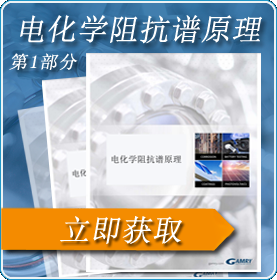Tips and Techniques for Improving Potentiostat Stability
Overview
This application note is meant to provide you with several tips and techniques for improving potentiostat stability. Potentiostats can become unstable for several reasons. Improving the stability may require trying several different techniques.
Capacitive Cells and Stability
All potentiostats can become unstable when connected to capacitive cells. The capacitive cell adds phase shift to the potentiostat's feedback signal (which is already phase shifted). The additional phase shift can convert the potentiostat's power amplifier into a power oscillator.
To make matters worse, almost all electrochemical cells are capacitive because an electrical double layer forms next to a conductor immersed in a solution.
Potentiostat oscillation is an AC phenomenon. However, it can affect both AC and DC measurements. Oscillation often causes excessive noise or sharp DC shifts in the system's graphical output. Typically a potentiostat can be stable on less sensitive current ranges and unstable on more sensitive current ranges. Whenever you see sharp breaks in the current recorded on the system, you should suspect oscillation.
Gamry potentiostats have been tested for stability with cell capacitors between 10 pF and 3000 F. In all but its fastest control amp speed setting, it is stable on any capacitor in this range -- as long as the impedance in the reference electrode lead does not exceed 20 kΩ. With reference electrode impedances greater than 20 kΩ, the potentiostat may oscillate. The RC filter formed by the reference electrode impedance and the reference terminal's input capacitance filters out the high frequency feedback needed for potentiostat stability.
Longer cell cables make the problem worse by increasing the reference terminal's effective input capacitance.
Even when the system is stable (not oscillating), it may exhibit ringing whenever there is a voltage step applied to the cell. While this ringing is not a problem with slow DC measurements, it can interfere with faster measurements. The steps taken to eliminate potentiostat oscillation also help to minimize ringing.
Improving Potentiostat Stability
There are a number of things that you can do to improve an unstable or marginally stable potentiostat/cell system. This list is not in any particular order. Any or all of these steps may help.
- Slow down the potentiostat. Gamry potentiostats have several control amplifier speed settings, which can be selected in software. Slower settings are generally more stable.
- Increase the potentiostat’s I/E stability setting. Gamry potentiostats include capacitors that can be paralleled with its I/E converter resistors. These capacitors are connected to relays that are under software control. Contact your local Gamry Instruments representative for more information concerning changes in these settings.
- Lower the reference electrode impedance. Make sure that you don't have a clogged reference electrode junction. Avoid asbestos fiber reference electrodes and double-junction electrodes. Avoid small diameter Luggin capillaries. If you do have a Luggin capillary, make sure that the capillary’s contents are as conductive as possible.
Add a capacitively-coupled low impedance reference element in parallel with your existing reference electrode. The classic fast combination reference electrode shown in Figure 1 is a platinum wire and a junction isolated SCE. The capacitor insures that DC potential comes from the SCE and AC potential from the platinum wire. The capacitor value is generally determined by trial and error.
Figure 1. Fast Combination Reference Electrode

Provide a high frequency shunt around the cell. A small capacitor between the red and white cell leads allows high frequency feedback to bypass the cell. See Figure 2. The capacitor value is generally determined by trial and error. One nF (1000 pF) is a good starting point.
In a sense, this is another form of an AC coupled low impedance reference electrode. The counter electrode is the low impedance electrode, eliminating the need for an additional electrode in the solution.
Figure 2. High Frequency Shunt

- Add resistance to the counter electrode lead. See Figure 3. This change lowers the effective bandwidth of the control amplifier. As a rule of thumb, the resistor should be selected to give one volt of drop at the highest current expected in the test being run. For example, if you expect your highest current to be around 1 mA, you can add a 1 kΩ resistor.
Though this resistor has no effect on the DC accuracy of the potentiostat, it can create problems in high speed experiments such as fast CV scans or EIS, which need high bandwidth.
Figure 3. Resistor Added for Stability

Want a PDF version of this application note?
Please complete the following form and we'll mail a link to your inbox!



